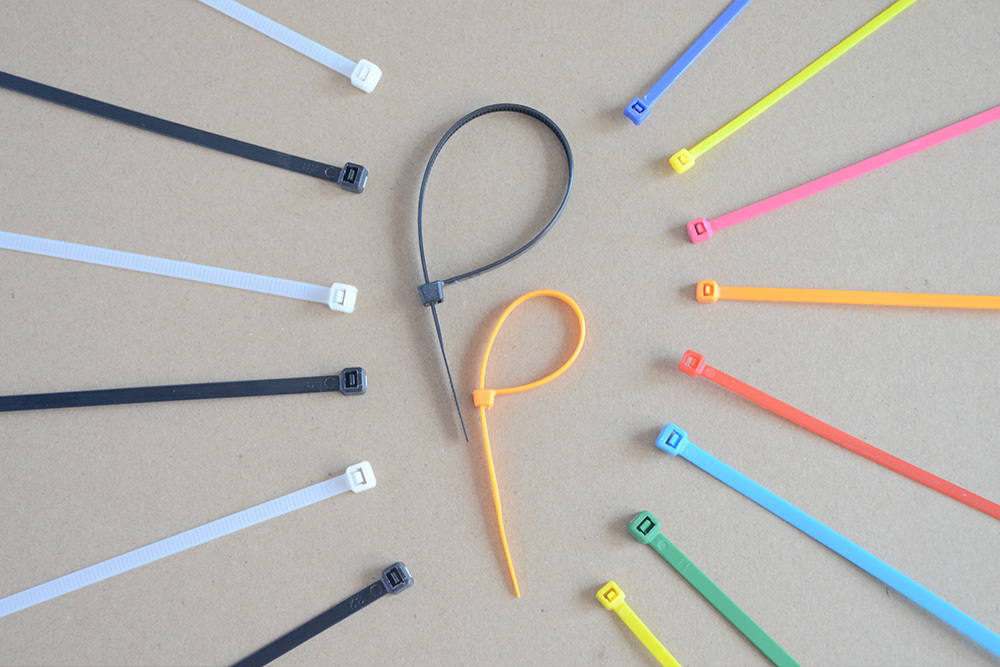12
2025
-
10
Non-fading plastic cable tie material
Author:
Durable and Fade-Resistant Plastic Cable Ties: Material Selection and Advantages
Plastic cable ties are indispensable for bundling, securing, and organizing items across industries. When longevity and color retention are critical, selecting the right material ensures performance under prolonged exposure to sunlight, chemicals, or environmental stressors. Below, we explore the key materials that prevent fading and enhance durability.
UV-Stabilized Nylon for Outdoor Resilience
Nylon-based cable ties, particularly those made from nylon 66 (PA66), are widely used for their strength and resistance to abrasion. However, standard nylon can degrade under UV radiation, leading to color fading and brittleness. To address this, manufacturers incorporate UV stabilizers into the nylon matrix:
- Mechanism of Action: UV stabilizers absorb harmful ultraviolet rays, preventing them from breaking chemical bonds in the polymer. This extends the tie’s lifespan in outdoor settings, such as solar panel installations or agricultural applications.
- Applications: Ideal for construction sites, outdoor signage, and marine environments where ties are exposed to direct sunlight for extended periods.
- Performance: UV-stabilized nylon retains its flexibility and tensile strength even after years of exposure, reducing the need for frequent replacements.
By integrating UV protection, nylon cable ties maintain their structural integrity and appearance, making them a cost-effective choice for long-term projects.
Colorfast Polypropylene for Cost-Effective Solutions
Polypropylene (PP) is a lightweight, chemically resistant material commonly used in packaging and temporary bundling. While PP is less UV-resistant than nylon, it can be modified to resist fading:
- Additives for Color Retention: Manufacturers blend PP with pigments and stabilizers that resist oxidation and light-induced degradation. These additives ensure the ties retain their color in indoor or shaded outdoor environments.
- Advantages: PP ties are more affordable than nylon and suitable for applications where extreme durability is unnecessary. They resist acids, bases, and solvents, making them ideal for food packaging, warehouses, or indoor cable management.
- Limitations: PP ties may fade faster than UV-stabilized nylon when exposed to intense sunlight, limiting their use in unshaded outdoor settings.
For projects prioritizing cost over longevity, colorfast PP ties offer a reliable and economical solution.
High-Performance Polymers for Specialized Environments
Certain applications demand materials that exceed the capabilities of standard nylon or PP. Advanced polymers provide tailored solutions for extreme conditions:
- Polyether Ether Ketone (PEEK): PEEK ties withstand temperatures exceeding 250°C and resist chemicals, making them suitable for aerospace, automotive engines, or oil and gas industries. Their inherent color stability ensures visibility in high-heat environments.
- Polyphenylene Sulfide (PPS): PPS ties offer exceptional dimensional stability and flame resistance, retaining color even in harsh industrial settings. They are used in electrical insulation and automotive components where thermal cycling is common.
- Biodegradable Options: For eco-conscious projects, biodegradable polymers like PLA (polylactic acid) can be formulated with colorants that resist fading during their functional lifespan. These ties degrade naturally after use, reducing environmental impact.
These specialized materials cater to niche markets where standard options fail, ensuring performance without compromising on aesthetics.
Environmental Factors Influencing Fade Resistance
The choice of material must align with the operating environment to maximize fade resistance:
- Sunlight Exposure: UV-stabilized nylon outperforms PP in direct sunlight, while PP suffices for shaded or indoor use.
- Chemical Exposure: PEEK and PPS resist solvents and acids, maintaining color integrity in chemically aggressive settings.
- Temperature Fluctuations: High-temperature polymers like PEEK prevent fading and deformation in extreme heat, whereas standard nylon may degrade.
By matching the material to environmental stressors, users can avoid premature fading and ensure reliable performance.
Color Selection Strategies for Longevity
Beyond material choice, color selection impacts fade resistance:
- Darker Shades: Black, blue, and green ties often contain pigments that resist UV degradation better than lighter colors like yellow or white.
- Metallic Finishes: Some manufacturers offer ties with metallic coatings that reflect UV rays, enhancing color retention.
- Transparent Options: Clear ties eliminate pigment-related fading but may yellow over time due to polymer degradation. UV-stabilized clear ties mitigate this issue.
Strategic color selection complements material choice, further extending the ties’ visual and functional lifespan.
plastic cable ties
Previous Page
Previous Page
Hot News
2025-10-12
The correct binding method for plastic cable ties
Plastic cable ties are widely used across industries for bundling wires, securing pipes, or organizing components. When applied correctly, they provide reliable, long-lasting support. However, improper绑扎 (tying) methods can lead to loosening, breakage, or uneven stress distribution. Below, we explore step-by-step techniques to ensure optimal performance without compromising structural integrity.
2025-10-12
Non-deformable plastic cable tie design
Plastic cable ties are essential for securing cables, pipes, and components in industries ranging from construction to automotive manufacturing. However, deformation under tension, temperature fluctuations, or repeated use can compromise their effectiveness. By focusing on material selection, structural engineering, and locking mechanisms, designers can create ties that maintain their shape and strength over time. Below, we explore the key strategies for achieving minimal deformation.
2025-10-12
Non-fading plastic cable tie material
Plastic cable ties are indispensable for bundling, securing, and organizing items across industries. When longevity and color retention are critical, selecting the right material ensures performance under prolonged exposure to sunlight, chemicals, or environmental stressors.
2025-10-10
Advantages of customizable plastic cable ties
Customizable plastic cable ties have become a cornerstone in industries requiring precision, efficiency, and brand differentiation. Unlike standard off-the-shelf options, these ties offer flexibility in design, material, and functionality, enabling businesses to address unique challenges. Below, we explore the key benefits of opting for customizable solutions.

